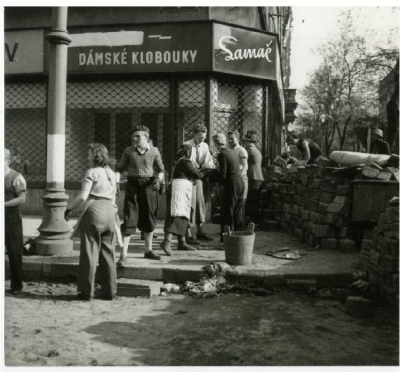The military occupation of Czechoslovakia by Nazi Germany began with the German annexation of the Sudetenland in 1938, continued with the creation of the Protectorate of Bohemia and Moravia, and by the end of 1944 extended to all parts of Czechoslovakia.
Following the Anschluss of Austria to Nazi Germany in March 1938 and after he had obtained the Munich Agreement in September 1938, Adolf Hitler annexed the ethnic Germans living in Czech regions. The loss of Sudetenland was detrimental to the defense of Czechoslovakia as the extensive Czechoslovak border fortifications were also located in the same area. As a consequence, the incorporation of the Sudetenland into Germany that began on 1 October 1938 left the rest of Czechoslovakia weak. Moreover, a small northeastern part of the borderland region known as Zaolzie was occupied and annexed to Poland ostensibly to "protect" the local ethnic Polish community and as a result of previous territorial claims (Czech-Polish disputes in the years of 191820). Furthermore, by the First Vienna Award, Hungary received the southern territories of Slovakia and Carpathian Ruthenia, which were largely inhabited by Hungarians.
As the Slovak State was proclaimed on 14 March, the next day Hungary occupied and annexed the remainder of Carpathian Ruthenia. On 15 March 1939, during a visit to Berlin, the Czechoslovak president Emil Hcha was bullied into signing away his country's independence. On 16 March 1939, Hitler proclaimed the Protectorate of Bohemia and Moravia from Prague Castle, leaving Hcha as technical head of state with the title of State President. However, he was rendered all but powerless; real power was vested in the Reichsprotektor, who served as Hitler's personal representative.In March 1944, during Operation Margarethe Hungary was occupied by Germany, while beginning at the end of August 1944 with the Slovak National Uprising, Slovakia shared the same fate. The occupation ended with the surrender of Germany following World War II. During the German occupation between 294,000 to 320,000 citizens (including Jews, making up most of the casualties) were murdered. Reprisals were especially harsh in the aftermath of the assassination of Reinhard Heydrich (e.g. the infamous and widely published Lidice massacre). Large numbers of people were drafted for slave labour in Germany.
The Prague uprising (Czech: Pražské povstání) was a partially successful attempt by the Czech resistance to liberate the city of Prague from German occupation in May 1945, at the end of World War II. The preceding six years of occupation had fuelled anti-German sentiment and the approach of the Soviet Red Army and the US Third Army offered a chance of success.
On 5 May 1945, in the last moments of the war in Europe, Czech citizens spontaneously attacked the German occupiers and Czech resistance leaders emerged from hiding to join the uprising. The Russian Liberation Army, which had been fighting for the Germans, defected and supported the Czechs. German troops counter-attacked, but their progress was slowed by barricades constructed by the Czech citizenry. On 8 May, the Czech and German leaders signed a ceasefire allowing the German forces to withdraw from the city, but not all Waffen-SS units obeyed. Fighting continued until 9 May, when the Red Army entered the nearly liberated city.
The uprising was brutal, with both sides committing war crimes. The German side used Czech civilians as human shields and committed massacres. Violence against German civilians, sanctioned by the Czechoslovak government, continued after the liberation, and was justified as revenge for the occupation or as a means to encourage Germans to flee. George Patton’s US Third Army was ordered by General Dwight Eisenhower not to come to the aid of the Czech insurgents, which undermined the credibility of the Western powers in postwar Czechoslovakia. Instead, the uprising was presented as a symbol of Czech resistance to Nazi rule, and the liberation by the Red Army was used by the Czechoslovak Communist Party to increase popular support for the party.

1945May, 5
World War II: The Prague uprising begins as an attempt by the Czech resistance to free the city from German occupation.
Choose Another Date
Events on 1945
- 23Feb
Manila
World War II: The capital of the Philippines, Manila, is liberated by combined Filipino and American forces. - 23Feb
History of Poland (1939-45)
World War II: Capitulation of German garrison in Poznań. The city is liberated by Soviet and Polish forces. - 25Feb
Turkey
World War II: Turkey declares war on Germany. - 9Mar
Atomic bombings of Hiroshima and Nagasaki
World War II: The first nocturnal incendiary attack on Tokyo inflicts damage comparable to that inflicted on both Hiroshima and Nagasaki five months later. - 30Aug
Douglas MacArthur
The Supreme Commander of the Allied Forces, General Douglas MacArthur lands at Atsugi Air Force Base.

 English
English  español
español  français
français  português
português  русский
русский  العربية
العربية  简体中文
简体中文 